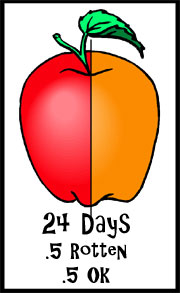After looking at all six dinosaur fossils you might have a good idea of which dinosaur could have created the mysterious tracks. Let's review what we have so far.
- The animal that created the track was bipedal, it walked on two feet.
- The animal that created the tracks had three toes.
- If we compare tracks from animals that are alive today with the mysterious track, the closest match is a bird track.
- After further investigation, scientists agree that the animal that most likely could have made the track was a bipedal, three toed dinosaur.
After looking carefully at six different dinosaur fossils we discovered three of the fossilized skeletons were three toed and had small front limbs suggesting that they were bipedal. These dinosaurs were:
- The Iguanadon, which lived during the Cretaceous Period, 136 to 65 million years ago.
- The Stegoceras, which lived during the Jurassic Period, 193 to 137 million years ago.
- The Dilophosaurus, which lived during the Triassic Period, 225 to 194 million years ago.
At this point if scientists only knew how old the dinosaur tracks were, we might be able to match the mysterious tracks with one of the three found dinosaur fossils listed above.
We
now have a new mystery to solve.
How old is the mysterious dinosaur track?

How do scientists determine the age of rocks and fossils?
In the early 1900's scientists developed a technique called radiometric dating. This method of dating rocks is based on looking at how long it takes unstable radioactive substances such as Uranium to gradually produce stable non-radioactive substances like Lead.
This is great for dating igneous rocks because when these rocks form from the cooling of magma or lava they contain many unstable radioactive substances. (Don't worry, the level of radioactivity of a newly formed rock is so low it can't harm you, unless of course, the rock fell and hit you on the head.)
The decay of unstable radioactive substances into stable substances happens at a constant rate. This constant rate is called a half life, which is the time it takes for half a radioactive substance to decay into its non-radioactive stable form. If this is confusing look at the next sample apple example below. If you understand it, go get an apple and eat it while skipping ahead to how to calculate the age of the mysterious track.
What is a half life?
To better understand the concept of half life we will use the fictitious example of an apple that decays at a constant rate. Our example is fictitious because apples don't decay at a constant rate. Apples are organic and decay through bacterial decomposition, not radioactive decay.
Let's say we have an apple that takes 24 days for half of it to rot. We would call the half life of our apple 24 days.
Look carefully at what happens to an apple with a half life of 24 days over time.




Look carefully at how the apples change over time. Do you see a pattern?
Calculate what the apple will look like after 96 days.
• How much will be rotten?
• How much will still be OK?
You most likely will want to use a calculator.
Once
you have completed your calculations, use your mouse to roll over the
picture of the apple below
to see if you were right.

Below is a graph of our decaying apple. Study it carefully and answer the following question. If you found an apple that was 0.75 good and 0.25 rotten according to the graph, how old is it?
Once you think you've got it, use your mouse to roll over the graph to see your answer.

A rock doesn't rot, however the uranium in a rock will over time change to lead just as the delicious red apple changed to a soft mushy rotten apple. A scientist uses highly specialized microscopes and other devices to see how much uranium has changed to lead. An apple needs only a good eye, a touch, or a taste to understand if it is rotten or not.
Using radiometric decay to determine the age of the mysterious tracks.
The mysterious tracks were found in sandstone, and sandstone is a sedimentary rock. Unfortunately, radiometric dating works best for rocks that are newly created from magma or lava such as igneous rock. Sedimentary rocks such as our sandstone footprints are a great source of fossils, but radiometric dating of sedimentary rock is virtually impossible, because much of the radioactive material in sedimentary rocks once came from igneous rocks and there is no way of telling when the radioactive material eroded from the igneous rocks and finally became deposited in sediment. So to find a fossil's age, which is to figure out the age when a dead organism was trapped in sediment, scientists look to see if the rock with the fossils in it is sandwiched between layers of igneous rock. They then use radiometric dating to calculate the age of the igneous rock both above and below the fossil layer to get an idea of the age of the sedimentary layer and the fossils in it.
Look carefully at the picture below. As you can see, the igneous rock below the mysterious tracks are 350 million years old.
Use the Uranium to Lead graph to determine the age of the overlying igneous rocks and the approximate age of the mysterious dinosaur tracks.


Uranium 235 decays
to Lead 207, the half life for this decay is
704 million years.
From the cross section of the rocks that surround the layer of fossilized dinosaur tracks (picture) we can see that the overlying layer of igneous rock contains 85 per 100 atoms of Uranium 235 and 15 per 100 atoms Lead 207. Once you have calculated the age of the overlying igneous rock, use your mouse to roll over the graph and see if you were right.
 |
 |
|||||||||||||||||||||